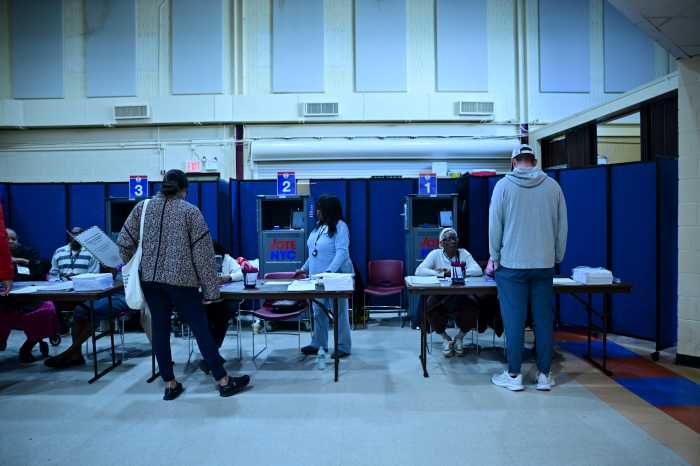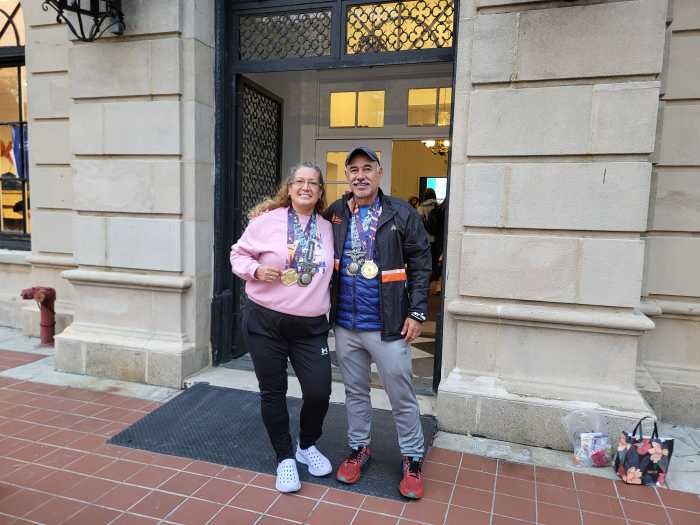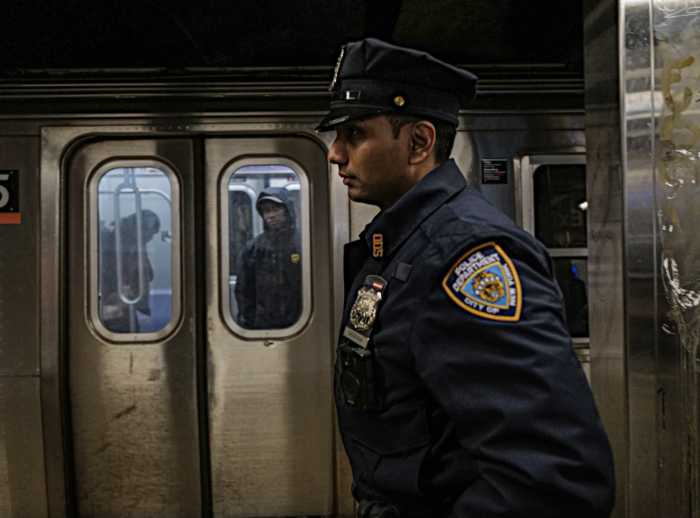At “Remembering Amber,” the tribute to Amber Hollibaugh on March 17, her friends, colleagues, and family recalled the life, times, and works of the “lesbian sex radical, ex-hooker, incest survivor gypsy child, poor-white-trash, high femme dyke,” who died last October, but whose work remains vital, and whose influence and ideas continue to reach new audiences.
“Some people thought of Amber as larger than life,” Jenifer Levin, Hollibaugh’s partner and spouse said, “but really, she was as large as life should be.”
The Catholics weren’t marching down Fifth Avenue on St. Patrick’s Day, because it was Sunday. Some of the people who’d once protested that parade were on Staten Island, marching in the new, inclusive parade, celebrating the falling away of the old, and the start of a new way, made possible by the work of people like Hollibaugh in weeks, months, and decades past.
“I am passionate about this kind of historical narrative, one which sets out to mark and detail the too-often forgotten, ridiculed lives most people lead,” Hollibaugh wrote in the introduction to her essay collection “My Dangerous Desires, a queer girl dreaming her way home.”
“My life as a queer woman, a too-poor girl, a mixed-race hooker, a left-wing activist was never meant to be remembered or told, never meant to endure or to count.”
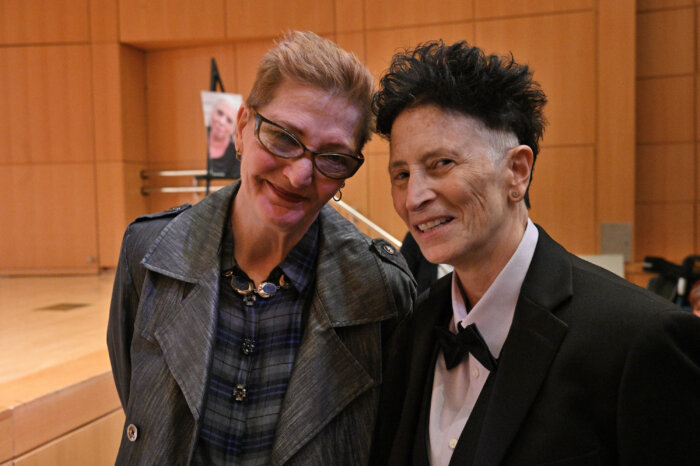
Hollibaugh’s life and work included some of the most important moments and movements for queer people in the 20th and 21st centuries, inclusive of personal, political, and economic struggles of queer people across class, race, and identity.
At Elebash Recital Hall at the CUNY Grad Center, once the grand B. Altman’s department store on Fifth Avenue, the venue was filled with people who’d come from the boroughs and across the country and the ocean, a group ranging from the young to community elders, queer and straight women, men, and everyone else.
Christian John Lillis and Beck-Jordan Young, who planned the event along with Debanuj Dasgupta, served as MCs, introducing the speakers and a film by Rodrigo Brandao.
Author and LGBTQ historian John D’Emilio recalled meeting Hollibaugh in San Francisco in 1979, and her speaking at a demonstration after the trial of Dan White for the murder of Harvey Milk.
“There was this tall, imposing blonde who said: ‘You have the right to be angry. Let me see your rage!’ And a row of police cars went up in flames.”
In California, Hollibaugh worked to stop the Briggs Initiative, a ballot proposition that sought to ban gays and lesbians from teaching in California public schools.
“I remember Amber making her way through small towns in California,” D’Emilio said, “moving through class and racial boundaries as a bold and tireless activist, saying what everyone else agrees not to notice.” The Briggs Initiative was defeated 57%-41%, with more than seven million ballots cast.

Interdisciplinary artist and teacher EG Crichton spoke of how she’d known Hollibaugh since 1971, when they protested the exclusion of queer content in “Our Bodies, Ourselves,” which eventually included the chapter, “In Amerika They Call us Dykes,” in its 1973 edition. At one point, Crichton recalled, Hollibaugh stalked out “furious about class issues” in the feminist publication. The two of them worked together in several political groups, “some righteous, some less than righteous.”
“I miss Amber, her intense love, and her wildly imaginative storytelling,” Crichton finished.
“I often dream about Amber,” Debanuj Dasgupta said. “I have Amber moments, her silver-blonde hair flipping, saying ‘well sweetie, darling’…laughing, saying ‘can you believe what these Nieman-Marcus Marxists are doing?’…converting bitching into social critique.” Dasgupta, a queer, trans immigrant teacher and scholar, spoke of how Hollibaugh showed them “how to tell the story of a queer refugee,” and that the last time they’d met in person, “she gave me a hug that made me feel seen, full of friendship and praxis.”
Christian John Lillis, “a working-class, Irish-Catholic queer femme writer,” standup comic, and health activist described meeting Hollibaugh as a “close second” for the greatest moment of his life, “dancing with Madonna at Sound Factory when I was 17.” Lillis described Hollibaugh “as brilliant on the fly as in her writing,” and recalled that Hollibaugh had validated his identity and helped him embrace it.”
Kenyon Farrow talked about his long history with Hollibaugh working with her in organizations including Queers for Economic Justice, focusing on the needs of working class queer people, and on the Beyond Marriage Statement, in which over 250 LGBTQ activists and leaders, writers and artists, organizers and lawyers, allies and celebrities sought to reframe the marriage equality debate in the United States as part of a larger effort to strengthen the stability and security of diverse households and families.
“We talked about ways of being in the world,” he said, “thinking about the things that can be tools to move toward more justice.”
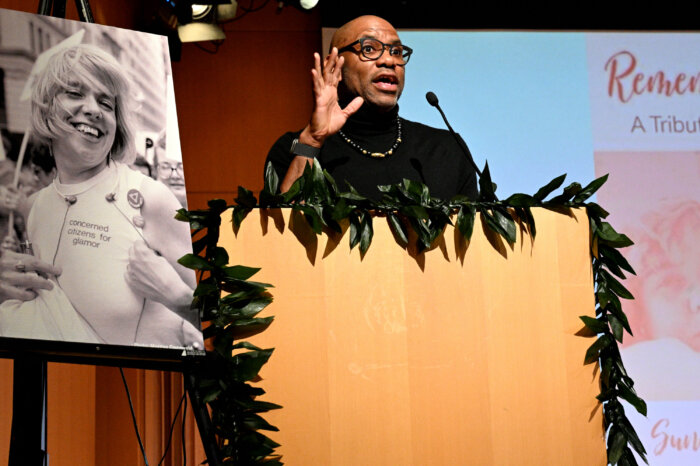
Interdisciplinary feminist scientist and science studies scholar Beck Jordan-Young spoke of Amber as her “older sister” who “treated me as her peer” in favorite restaurants, cooking for each other, on Fire Island, and in a jail cell in Washington, DC after protesting the 1986 Bowers vs. Hardwick ruling in which the Supreme Court ruled there was no constitutional protection for queer sex, and that states could outlaw its practice. Jordan-Young talked about how Hollibaugh’s great friend Dorothy Allison, who wrote the foreword to “My Dangerous Desires,” helped inform Hollibaugh’s thinking and writing.
In Rodrigo Brandao’s film, the audience got to hear from Hollibaugh herself, in excerpts from Jean Carlomusto’s film, “Esther Newton Made me Gay,” as well as from friends, family and colleagues including Lucy Jane Bledsoe, Jay Toole, Lissa Duggan, Barbara Satin, Joan Nestle, Rebecca Voelkel, and Felice Picano, who introduced Hollibaugh and Levin to each other in a bookstore. Levin’s sons with Julie DeLaurier, Mak and Van, spoke of Hollibaugh as a family member who cooked outstanding fish vindaloo and loved to watch football.
PJ Starr, filmmaker, photographer, and advocate for the rights of sex workers, immigrants and the LGBTQ community, spoke of Hollibaugh as “our dearest friend, who has ascended to where the greatest whores go,” remembering her as a sex worker, “writer, filmmaker, and excellent whore.” Starr waved a long red scarf in celebration, sending it twirling into the audience, and removed her jacket in a stylized striptease to honor her friend. She spoke of the work they did with little to no money, offering up a prayer Hollibaugh taught her: “May your wallets be filled and your cups overflow.”
“May your memory be a revolution,” poet and disability activist Eli Clare said, recalling that he was “entirely starstruck” when he met Hollibaugh at the Queer Disability Conference, the first international gathering of disabled queers, in 2002.
Queer activist Beth Zemsky spoke of “the privacy of passion across differences, space and time,” in her long friendship with Hollibaugh, whom she lovingly called “Amber the yenta,” and said “all of my partners had to pass the Amber test.”
In a sign of the times, one of the speakers, Joseph Nicholas DeFilippis, came to town to speak, but contracted COVID, and his remarks were shared by author and activist Terry Boggis, who read selections of work by DeFilippis’s students, whose lives and minds had been opened by reading Hollibaugh’s work.
Broadcaster and journalist Laura Flanders was overcome with emotion as she remembered Hollibaugh. “What we have is one another: pals, comrades, people we recognize. There was so much great, radical, gleeful stuff in that one gorgeous package.”
The final words were left to Jenifer Levin, Hollibaugh’s partner for 26 years, who ascended to the stage in a tuxedo and black boots, and gently handed P.J. Starr the jacket she’d thrown to the stage.
“We’re here, we’re queer, we love, we hate, we break up, we reconstitute, we learn to love again…get used to it!”
She recalled Hollibaugh as a stepparent (“Think Auntie Mame,”) a filmmaker, stock car trophy girl, and revolutionary. “Pride is cool, don’t get me wrong, but liberation is a whole different animal.”
Levin shared anecdotes sweet, funny, and sad of their life together.
“Amber knew our bodies and minds are wired for ecstasy,” Levin said. “She was brilliant and capable of profound tenderness.”
Hollibaugh’s health declined in her last few years, and she spent less time with friends and loved ones. Earlier in the event, one of the speakers expressed sadness that she had not been able to enjoy her retirement. She remained present for friends, including those with other health struggles. Another speaker recalled spending time at the bedside of their great friend Jeffrey Escoffier when he was dying in 2022. They sang, spoke to him, held his hands, and read to him.
Hollibaugh told Levin that they were “walking him home.”
“We’re all just walking each other home,” Levin said.










